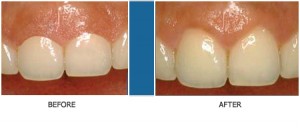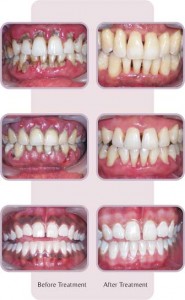picture source from www.stevemocrae.com
Before and after Gingivectomy procedure
The first 5 letters of either word gives away its meaning that it has something to do with the gingival or more commonly, the gums. However, both these words carry different meanings about the procedure that is been done to the gums. In this article, we shall discuss about them.
Gingivectomy?
What?
A procedure to remove loose gum tissue. This procedure is usually done by a periodontist ( a specialist in gums ).
How?
Below is a very brief flowchart on the procedure of gingivectomy.
Gingivectomies are slightly more time consuming than gingivoplasty and can range up to an hour of operation time if the extent of surgery is large.
Gingivoplasty?
What?
Gingivoplasty is a procedure to surgically reshape and re-contour the outer surface of the gum tissue for cosmetic, physiological, or functional purposes. Â They can be carried out alone, to reshape the remaining gums, or after gingivectomy as an adjunct to reshape the unsightly surgical site.
How?
The procedure is similar to that of gingivectomy ( seen in the flowchart above ) with the exception that the base of the pocket is not marked and incisions are made conservatively. The gums are shaped and unwanted tissues that cause asymmetry or malformation are removed. Gingivoplasties are usually quick and simple and can just take up to a couple of minutes to complete.
Before and after Gingivoplasty procedure
So about Gingivectomy and Gingivoplasty…
Both these procedures are very commonly performed in combination together, complementing each other in order to give the patient a beautiful cosmetically pleasing smile.
credits to mohadental.com
Cost?
Fees to remove damaged or excess gum tissue start around $190 -$300 for one tooth and can run $500 -$850 per quadrant (upper right, lower right, upper left, lower left) or $2,000 -$4,000 or more for the whole mouth.
Why?
Formation of deep pockets which are hard to clean / hygienically compromised
Cosmetic reasons when teeth appear ‘short’ due to it being sunken under enlarged gums
Enlargement of the gums ( can be caused by disease, genetic defects and even certain drugs )
Elimination of suprabony infections or abscesses
Shaping of gum asymmetry, malformation.
Healing?
Healing like all things is not instantaneous. A periodontal dressing has to be applied for up to 10 days. Even so, complete healing of the affected tissues can take up anywhere from 1-3 months and may be delayed by non-compliance of the patient, or due to underlying systemic pathologies.
Pain?
Surgery is usually painless due to the administration of local anesthetic, which totally numbs the surgical site. However, post –surgical discomfort is bound to be expected as the anesthesia wears off slowly. This can be easily managed with over the counter drugs like ibuprofen or even paracetamol.
Post operative care?
It’s a surgery, hence post surgical care is a must. When the surgical procedure has been completed, a periodontal dressing  is placed over the site where gingival tissue was removed to protect and help seal it during the healing process.
A soft diet highly recommended for a week to ten days following treatment to avoid unnecessary damage and trauma.
Painkillers and an antiseptic mouthwashes are recommended. To a certain extent, antibiotics may also be prescribed by the surgeon as prevention against any post operative infection.
It is imperative that the teeth around the surgical site are not brushed while the periodontal pack is in place.  Oral hygiene is maintained with mouthwash. After removal of the periodontal dressing can soft brushing and flossing around the affected area commence.
Danger?
Both are considered to be very safe and simple surgeries. There is a risk of infection from the surgical site which is easily managed with the prescription of prophylactic antibiotics. Slight bleeding is also a common complication but usually subsides after 1 to 2 days.
When in doubt however, it is always best to get it reviewed by the periodontist.

